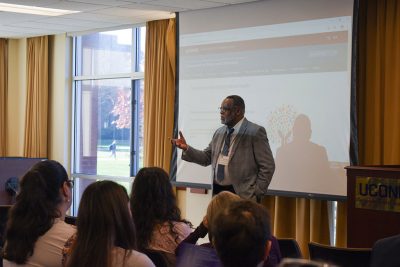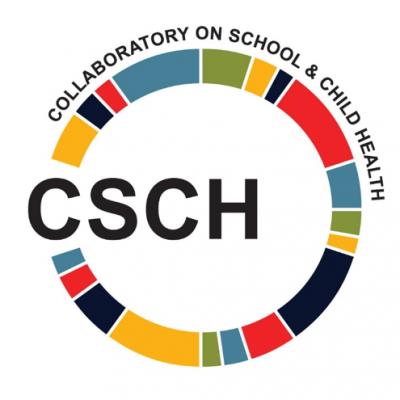
Representatives from Connecticut school systems, state agencies, higher education institutions, and nonprofit organizations gathered at the University on Wednesday, Oct. 23, to develop collaborative plans to broaden school and community mental health services across the state and address issues surrounding childhood trauma.
The “Trauma-Informed School Mental Health Symposium 2.0” was brought together by the University of Connecticut Collaboratory on School and Child Health (CSCH), Ana Grace Project, Capitol Region Education Council, Child Health Development Institute, Clifford Beers Clinic, state Department of Children and Families (DCF), Connecticut State Department of Education, and Neag School of Education.
The first trauma symposium was held in May 2017, where school, mental health, and community leaders worked to increase awareness surrounding school mental health and develop possible strategies to respond to children who have experienced trauma.
“Last time, we focused on talking about it, on thinking about it. This time, we are focused on getting it done,” said Jeana Bracey, associate vice president for school and community initiatives at the Child Health and Development Institute and co-chair of the Connecticut Trauma-Informed School Mental Health Task Force, a group that was formed at the 2017 symposium.
Sandra Chafouleas, UConn Board of Trustees Distinguished Professor, co-director of UConn’s CSCH, and co-chair on the School Mental Health Task Force with Bracey, kicked off the morning by reminding attendees of the rarity of such an event and the impact that a gathering of like-minded individuals can have on mental health initiatives across the state.
“There isn’t anything you do that will be wasted or lost when you’re working in this space. There’s nothing to be lost by doing the work with integrity, with transparency, with collaboration.”
— Nelba Marquez-Greene,
Founder and Director, Ana Grace Project
“I don’t often get a chance to be in a room with such diverse audiences, and people, and perspectives who are all committed to child health, child mental health, and trauma,” she said. “That’s what we are here to talk about, and let’s take all of the collective power that we have and the ideas in our brains to talk about where we are going to go next and how we are going to change the landscape for what’s happening in Connecticut.”
‘There’s Nothing to be Lost’
Founder and director of the Ana Grace Project Nelba Marquez-Greene asked attendees to consider how and where to enter the conversation surrounding childhood trauma and school-based mental health reform. Marquez-Greene reflected on the Sandy Hook Elementary School shooting in which she lost her daughter, Ana Grace. Marquez-Greene said the Sandy Hook shooting offered an opportunity, a voice, and a vehicle for mental health reform, and a sense of urgency for communities to come together in the mental health space.
“There isn’t anything you do that will be wasted or lost when you’re working in this space,” says Marquez-Greene. “There’s nothing to be lost by doing the work with integrity, with transparency, with collaboration.”
Tim Marshall from the DCF encouraged attendees to join the monthly workgroup that formed from the first symposium in 2017, noting accomplishments such as developing multi-tiered systems of support guidelines for districts and state agencies in mental health reform; recommending mental health policy to state partners; and creating a dictionary of trauma-informed terms so that individuals from diverse agencies are able to communicate effectively on the topic of mental and behavioral health.
“We invite you all to continue this collaboration at your local level, wherever you sit, whether you’re a provider, a state agency, a school … to work across sectors to improve the outcomes for students in schools who have any kind of mental health or behavioral health challenges,” he said.
Before attendees moved into breakout sessions, DCF Deputy Commissioner Michael Williams spoke of expanding the conversation of school mental health reform to include the communities in which students live.
“When we talk about trauma-informed care, particularly in the school systems, let’s talk about it for all kids; let’s assure that every child, regardless of race or ethnicity or citizenship status or language ability, gets the same outcomes when they get services,” said Williams.
“In Connecticut, we have a lot to be proud of, but there is still a lot of work to do. We can’t rest on our laurels. When we talk about trauma-informed care, let’s make sure we’re talking about all kids.”
— Michael Williams,
Deputy Commissioner, DCF
Shaping Goals and Recommendations
Facilitated breakout discussion groups tackled different questions involving trauma-informed school mental health, including topics on screening and early identification, aligning policies and practices to facilitate sustainability, and building collaborations across public-private partnerships.
During a breakout session on enhancing services to meet intensive needs, for instance, a diverse group of stakeholders in the mental health field compared the student services that are currently being used within their institutions and discussed the costs and benefits that have resulted. Through discussion, the group devised five key goals for trauma-informed education practices across the state:
- alignment between Individualized Education Program (IEP) services;
- universal screening practices and tools;
- enhanced collaboration between schools, behavioral health providers, and medical providers;
- a resource map that shows how schools can access services and where such services fit within their school structure; and
- greater efforts to engage families in intensive intervention for their children.
To close the event, breakout groups shared the big ideas for mental-health reform that came out of their discussions, many of which focused on creating uniformity between schools and mental health agencies.
 The findings from the second symposium will be used to broaden and align work around trauma-informed schools in Connecticut. In the week following the event, Chafouleas served as the lead presenter for a state legislative briefing on student well-being, where she shared policy recommendations based on the conclusions drawn in the symposium, along with her own presentation on Integrated Multi-Tiered Systems of Support (I-MTSS) for students.
The findings from the second symposium will be used to broaden and align work around trauma-informed schools in Connecticut. In the week following the event, Chafouleas served as the lead presenter for a state legislative briefing on student well-being, where she shared policy recommendations based on the conclusions drawn in the symposium, along with her own presentation on Integrated Multi-Tiered Systems of Support (I-MTSS) for students.
Chafouleas identified the problems that currently exist in how Connecticut school systems support the social, emotional and behavioral health of students, such as the lack of core features and strategies to create comprehensive systems of support. She suggested integrating policy and practice that emphasizes school well-being and support for the students across academic, social, emotional and behavioral sectors, along with embracing schools as primary systems of care.
She presented the following major recommendations to the legislature:
- Commit to focus on sustainability of evidence-informed strategies.
- Identify state-level metrics of success that demonstrate inclusion of social, emotional, and behavioral (SEB) outcomes.
- Create statewide consensus on what SEB screening, including universal mental health screening, should look like, and provide a roadmap on how to do it.
- Strengthen district awareness of, and support around, evidence-informed tiered behavioral support strategies.
- Identify and remedy cross-sector barriers related to access to appropriate behavioral supports for students and staff.
- Enhance outreach with families, communities, and schools around the importance of this work and existing resources.
- Recognize that school staff are experiencing secondary trauma and require social-emotional supports.
“In Connecticut, we have a lot to be proud of, but there is still a lot of work to do,” said Williams of the DCF. “We can’t rest on our laurels. When we talk about trauma-informed care, let’s make sure we’re talking about all kids.”
A summary of the work done to date since the first symposium can be found at crec.org/c/tis.
View photos from the event.
 Facebook
Facebook
 Twitter
Twitter
 LinkedIn
LinkedIn
